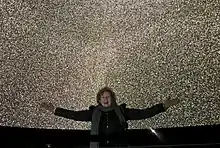Alyssa A. Goodman
Alyssa Ann Goodman (born July 1, 1962)[2] is the Robert Wheeler Willson Professor of Applied Astronomy at Harvard University, co-Director for Science[3] at the Radcliffe Institute for Advanced Study, Research Associate of the Smithsonian Institution, and the founding director of the Harvard Initiative in Innovative Computing.[4]
Alyssa A. Goodman | |
|---|---|
 Goodman at New York's Hayden Planetarium, December 2019 | |
| Born | Alyssa Ann Goodman July 1, 1962 New York City, New York, United States |
| Alma mater | Massachusetts Institute of Technology Harvard University |
| Awards | Newton Lacy Pierce Prize, Harvard Foundation Scientist of the Year, 2015 |
| Scientific career | |
| Fields | Astronomy |
| Thesis | Interstellar Magnetic Fields: An Observational Perspective (1989) |
| Doctoral advisor | Irwin I. Shapiro |
| Other academic advisors | Charles R. Alcock[1] |
| Influenced | Pete Buttigieg |
| Website | www |
Education
A native of New York, Goodman attended Herricks High School in New Hyde Park, New York. She later received her B.S. in Physics from the Massachusetts Institute of Technology in 1984. She then continued her education at Harvard University receiving a Ph.D also in Physics in 1989.
Career
Goodman's research is conducted at the Harvard-Smithsonian Center for Astrophysics in Cambridge, Massachusetts where she studies the dense gas between stars. In particular, her research interest is on how interstellar gas arranges itself into new stars.
Goodman is also a principal investigator of the COMPLETE Survey of Star-Forming Regions,[5] which maps out three large star-forming regions in the galaxy in their entirety. Goodman's personal research presently focuses primarily on new ways to visualize and analyze the tremendous data volumes created by large and/or diverse astronomical surveys. She has worked closely with Curtis Wong and Jonathan Fay on the Microsoft WorldWide Telescope project[6] at Microsoft Research and the American Astronomical Society to create, open-source, and enhance the use of the WorldWide Telescope, a computer program offering a virtual online universe to researchers and educators. Goodman was named “Scientist of the Year” by the Harvard Foundation in 2015.[7]
She has served on several data-related institutional and government advisory committees, including the National Academy's Board on Research Data and Information,[8] and the NSF-sponsored Council on Big Data, Ethics, and Society.[9] From 2008 to 2009, Goodman was a "Scholar-in-Residence" at WGBH, while on sabbatical.
Honors
- Elected a Legacy Fellow of the American Astronomical Society (2020) [10]
- Harvard Foundation's 2015 Scientist of the Year[11]
- Bok Prize, Harvard (1998)
- Newton Lacy Pierce Prize in Astronomy from the American Astronomical Society (1997)
References
- "Alumni/ae Notes" (PDF). Physics@MIT Journal (Fall 2001). 2001.
- Goodman, Alyssa (February 2010). "Curriculum Vitae" (PDF). Harvard University. Retrieved 14 October 2013.
- "Alyssa A. Goodman". Radcliffe Institute for Advanced Study at Harvard University. 2017-06-19. Retrieved 2019-12-08.
- Reid, Rosalind. "Initiative in Innovative Computing". Harvard University. Retrieved 14 October 2013.
- Goodman, Alyssa (19 Sep 2011). "The COordinated Molecular Probe Line Extinction Thermal Emission Survey of Star Forming Regions". Harvard University. Retrieved 14 October 2013.
- "A look at the editors: Alyssa Goodman". The Fourth Paradigm. Nov 8, 2010. Retrieved 14 October 2013.
- "Harvard Foundation to honor Goodman as Scientist of the Year". The Harvard Gazette. March 17, 2015. Retrieved 24 March 2016.
- "Board on Research Data and Information (BRDI), Alyssa Goodman". The National Academies of Sciences, Engineering, and Medicine. 2016. Retrieved 24 March 2016.
- "COUNCIL FOR BIG DATA, ETHICS, AND SOCIETY, Members". Council for Big Data, Ethics, and Society. 2016. Archived from the original on 8 April 2016. Retrieved 24 March 2016.
- "AAS Fellows". AAS. Retrieved 28 September 2020.
- "An inspiration to students". April 1, 2015.